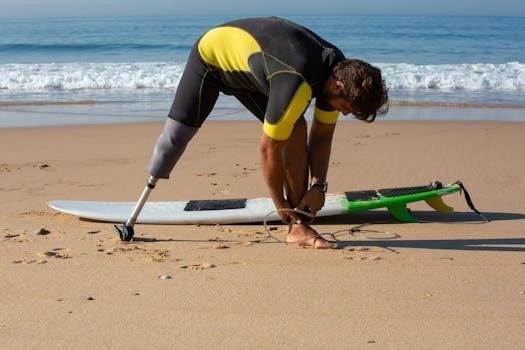Surfing is exhilarating! Choosing the right surfboard is essential for a fun and safe experience. Understanding surfboard sizing impacts performance.

Factors Influencing Surfboard Length
Selecting the correct surfboard length involves several key considerations. Skill level‚ height‚ weight‚ and wave conditions each play a vital role.
Surfer Skill Level
Your surfing skill level is a primary determinant in selecting the appropriate surfboard length. Beginners benefit most from longer boards‚ which offer enhanced stability and ease of paddling. These boards‚ often longboards or funboards‚ provide a forgiving platform for learning the fundamentals of surfing‚ such as popping up and maintaining balance. The increased surface area of a longer board makes it easier to catch waves‚ allowing beginners to focus on developing their technique without struggling to stay afloat. As surfers progress to the intermediate stage‚ they may transition to shorter‚ more maneuverable boards‚ like funboards or hybrid boards. These boards offer a balance between stability and responsiveness‚ enabling surfers to tackle a wider range of wave conditions and refine their skills. Advanced surfers typically prefer shortboards‚ which are designed for high-performance surfing. Shortboards require a higher level of skill and precision‚ as they are less stable and more sensitive to rider input. However‚ they offer unparalleled agility and speed‚ allowing experienced surfers to execute advanced maneuvers and carve through waves with ease. Ultimately‚ choosing a surfboard length that aligns with your skill level is crucial for maximizing your enjoyment and progression in the sport.
Surfer Height and Weight
In addition to skill level‚ a surfer’s height and weight are critical factors influencing the ideal surfboard length. These physical attributes directly impact buoyancy‚ stability‚ and maneuverability on the water. Taller and heavier surfers generally require longer and wider boards to provide adequate floatation and stability. A larger board ensures that the surfer doesn’t sink or struggle to paddle effectively. Conversely‚ shorter and lighter surfers may find shorter boards more manageable and responsive. A smaller board allows for easier turning and control‚ particularly in steeper or more powerful waves. It is important to consider both height and weight in conjunction‚ as a surfer who is tall but relatively light may still benefit from a slightly longer board to compensate for their height‚ while a shorter but heavier surfer may require a wider board to enhance stability. Using a surfboard size chart that takes both height and weight into account is a helpful tool in determining the appropriate board length. These charts provide a general guideline based on common ratios‚ but individual preferences and surfing style should also be considered. Experimenting with different board sizes and shapes can help surfers fine-tune their equipment to optimize their performance based on their unique physical characteristics.
Wave Conditions
The type of waves a surfer intends to ride significantly influences the ideal surfboard length. Different wave conditions demand specific board characteristics to maximize performance and enjoyment. Smaller‚ gentler waves typically require longer surfboards with greater volume. These boards provide increased stability and paddling power‚ allowing surfers to catch waves easily and maintain momentum in weaker conditions. Longboards and funboards are well-suited for these types of waves‚ as their length and width offer a stable platform for beginners and experienced surfers alike. On the other hand‚ larger‚ more powerful waves necessitate shorter‚ more maneuverable surfboards. These boards allow surfers to make quick turns and navigate steep drops with greater control. Shortboards and hybrid boards are commonly used in these conditions‚ as their reduced length and refined shape enhance responsiveness and agility. The shape and size of the wave itself also play a crucial role in determining the appropriate board length. For example‚ a long‚ drawn-out wave may be better suited for a longer board‚ while a short‚ punchy wave may require a shorter board with more rocker. Surfers should also consider the wave’s power and consistency when selecting a surfboard. A powerful‚ consistent wave may allow for a shorter board‚ while a weaker‚ inconsistent wave may necessitate a longer board to maintain speed and stability. Ultimately‚ understanding the characteristics of the waves you plan to surf is essential for choosing the right surfboard length and maximizing your surfing experience.

Surfboard Length Recommendations by Skill Level
Choosing the right surfboard depends on your skill level. Different boards cater to various experience levels for optimal performance.
Beginner Surfboards
If you’re new to surfing‚ opt for a longer‚ thicker surfboard with more volume. A larger board offers stability‚ easing wave catching and balance. Great beginner options include longboards and funboards‚ forgiving rides with more paddling power.
As a beginner‚ stability and ease of use are key. Start on small‚ gentle waves‚ which are better suited to bigger boards. A board that is wide‚ thick and at least three feet taller than you is a good rule of thumb‚ this will provide the needed stability. Longer surfboards generally provide more stability and are easier to paddle‚ making them ideal for beginners or surfers who want to ride smaller waves.
Weight‚ height‚ and skill level are crucial factors. A board suited to these will offer more stability. A longer board is better for beginners. Being realistic about your abilities is crucial; choose a size that aids progression. Consider the local wave conditions‚ and your surfing goals.
Intermediate Surfboards
If you’ve surfed a while and are comfortable‚ consider upgrading to a funboard or hybrid board. These offer a balance between maneuverability and stability‚ letting you tackle various waves and progress. Experiment with different board shapes and sizes at this stage!
As a general rule‚ the right board is usually one foot taller than your height. Weight‚ height‚ and skill level are critical factors. Being realistic about your abilities is crucial; choose a size that aids progression.
These mid-length surfboard designs tend to sit in the middle ground‚ offering versatility. A narrower board‚ on the other hand‚ provides better control and agility in larger waves. The ideal surfboard measurements considerably are affected by the different shapes of surfboards which are suited to different styles of surfing.
Consider local wave conditions and your surfing goals. Remember that different surfboard shapes are suited to different surfing styles‚ which affects the ideal surfboard measurements.
Advanced Surfboards
For experienced surfers comfortable on diverse waves‚ shortboards are the go-to. Designed for high-performance surfing‚ they offer agility‚ speed‚ and maneuverability for tricks and fast turns. These require skill and precision‚ not ideal for beginners or intermediates.
Aside from skill level‚ surfer weight‚ height‚ and fitness matter. It also depends on what you want the board to do. Different shapes of surfboards are suited to different styles of surfing‚ which affects the ideal surfboard measurements considerably.
Consider your honest skill level and choose a size that will help you progress. A shorter board‚ on the other hand‚ provides better control and agility in larger waves. These boards require more skill and precision‚ so they may not be ideal for beginners or intermediate surfers.
Advanced surfers often prefer boards with lower volume for greater maneuverability‚ allowing for more responsive turns and tricks. They are designed for high-performance surfing. Remember that different surfboard shapes are suited to different surfing styles‚ which affects the ideal surfboard measurements.

Surfboard Volume and its Impact
Surfboard volume refers to the amount of space inside the board‚ typically measured in liters. The volume directly affects the board’s buoyancy. A board with more volume will float higher on the water‚ making it easier to paddle and catch waves. Conversely‚ a lower volume board is more responsive and agile but requires more skill to balance.
For beginners or those learning to surf‚ boards with higher volume are highly recommended. They provide more stability and are easier to handle in the water. This helps in paddling‚ catching waves‚ and maintaining balance‚ which are crucial for beginners.
Experienced surfers typically prefer boards with lower volume for greater maneuverability‚ allowing for more responsive turns and tricks. They can handle the reduced stability due to their experience and skill level. This choice allows them to perform advanced maneuvers with greater ease.
Your weight‚ height‚ and skill level play a significant role in determining the right surfboard volume. A larger person will generally need a board with more volume to maintain buoyancy‚ while a smaller person may prefer a board with less volume. An advanced surfer will generally want less volume‚ so that his board can be more agile.

Other Considerations
In addition to skill level‚ height‚ and weight‚ consider wave types. Surfboard materials‚ rocker‚ and fin setup also impact performance.
Surfboard Materials
Surfboards are crafted from a variety of materials‚ each offering distinct performance characteristics that cater to different surfing styles and wave conditions. Understanding these materials is crucial in selecting a board that aligns with your needs and preferences. The most common materials include⁚
- Epoxy⁚ Epoxy surfboards are known for their lightweight construction and durability. They offer excellent buoyancy and responsiveness‚ making them ideal for smaller waves and surfers who prioritize maneuverability. Epoxy boards are also more resistant to dings and damage compared to traditional polyester boards.
- Polyester (PU)⁚ Polyester surfboards‚ often referred to as PU boards‚ are the traditional choice for many surfers. They provide a classic feel and offer a good balance of flex and responsiveness. PU boards are typically heavier than epoxy boards‚ which can provide more stability in choppy conditions.
- Foam Core⁚ The core of a surfboard is typically made of foam‚ with different types of foam affecting the board’s weight‚ flex‚ and buoyancy. Common foam types include polyurethane (PU) foam and expanded polystyrene (EPS) foam. PU foam is denser and provides a more traditional feel‚ while EPS foam is lighter and more buoyant.
- Wood⁚ Wood surfboards are becoming increasingly popular due to their eco-friendly nature and unique aesthetic appeal. They offer a smooth‚ stable ride and are often favored by surfers who appreciate a more traditional surfing experience. Wood boards can be heavier and more expensive than other types of surfboards.
- Carbon Fiber⁚ Carbon fiber is sometimes used in surfboard construction to enhance strength and stiffness. Carbon fiber stringers or reinforcements can improve a board’s responsiveness and prevent it from flexing excessively.
The choice of surfboard material depends on various factors‚ including your surfing skill level‚ the type of waves you plan to surf‚ and your personal preferences. Consider these materials carefully to make an informed decision and select a surfboard that will help you maximize your enjoyment in the water.
Rocker and Fin Setup
The rocker and fin setup of a surfboard significantly influence its performance characteristics‚ affecting maneuverability‚ speed‚ and stability; Understanding how these features interact with wave conditions and surfing styles is essential for selecting the right board.
Rocker⁚ The rocker refers to the curvature of the surfboard from nose to tail. Different rocker profiles are designed for different wave types and surfing preferences. A board with more rocker‚ characterized by a more pronounced curve‚ excels in steeper waves and allows for quick‚ tight turns. This type of rocker is ideal for experienced surfers who enjoy performing aggressive maneuvers. Conversely‚ a flatter rocker‚ with less curvature‚ provides greater stability and paddling ease‚ making it suitable for beginners and smaller waves. Flatter rocker boards also tend to generate more speed in less powerful conditions.
Fin Setup⁚ The fin setup is another critical factor that determines a surfboard’s handling characteristics. Common fin configurations include⁚
- Single Fin⁚ Offers a classic‚ smooth ride with excellent drive and stability.
- Twin Fin⁚ Provides increased speed and maneuverability‚ ideal for carving and generating lift.
- Thruster (Tri-Fin)⁚ The most popular setup‚ offering a balance of speed‚ control‚ and maneuverability.
- Quad Fin⁚ Enhances speed and grip‚ particularly in hollow waves‚ allowing for powerful turns.
- 5-Fin⁚ Offers versatility‚ allowing the surfer to switch between thruster and quad setups depending on wave conditions.
The choice of fin setup depends on your surfing style and the type of waves you typically ride. Experimenting with different fin configurations can help you fine-tune your board’s performance to match your preferences.
By carefully considering the rocker and fin setup in relation to your skill level and the waves you plan to surf‚ you can select a surfboard that enhances your surfing experience and helps you progress your skills.
